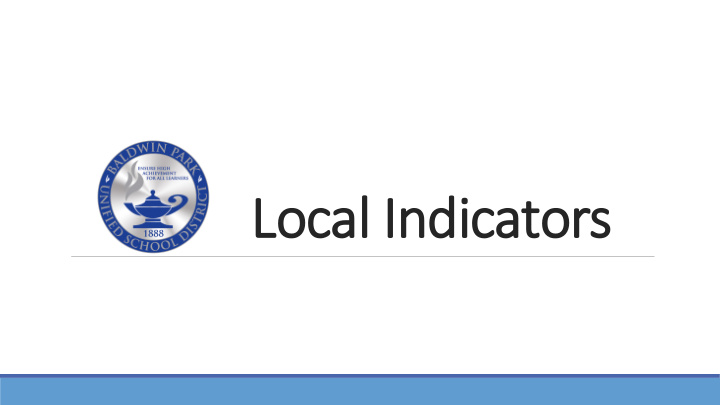



Loca cal Indi ndicator ors
Why L Local I Indicators rs? State data is not available for some priority areas identified in the Local Control Funding Formula statute. For these priority areas, the State Board of Education approved the local indicators, which are based on information that a local educational agency collects locally. Note: Local indicators do not apply to individual schools.
Requirem emen ents LEA annually measure its progress Results reported at a regularly scheduled public meeting of the local governing board Results reported to the public through the California Dashboard
Priority Area State Indicator Local Indicator Priority 1 – Basic Services or Basic Conditions at Schools Williams Monitoring Narrative Summary Priority 2 – Implementation of State Academic Standards Or Self-Reflection Tool Priority 3 – Parent Engagement Self-Reflection Tool Academic Indicator Priority 4 – Student Achievement English Learner Indicator Chronic Absence Indicator Priority 5 – Student Engagement Graduation Rate California Healthy Kids Priority 6 – School Climate Suspension Rate Survey Priority 7 – Access to a Broad Course of Study College Career Indicator Narrative Summary Priority 8 – Outcomes in a Broad Course of Study College Career Indicator
Priority ty 1: 1: Basi sic C Conditi tions a s at School ool 0 Number/percentage of misassignments of teachers of ELs, total teacher misassignments, and vacant teacher positions. 0 Number/percentage of students without access to their own copies of standards-aligned instructional materials for use at school and at home. 0 Number of identified instances where facilities do not meet the “good repair” standard (including deficiencies and extreme deficiencies).
Priority ty 2 2: Imple lementatio ion of of St State Acad adem emic Standards Professional Development 1. Exploration and Research Phase Instruction Manuals 2. Beginning Development Policy & Program Support 3. Initial Implementation Implementation of Standards 4. Full Implementation Engagement of School Leadership 5. Full Implementation and Sustainability
Priority ty 2 2: Imple lementatio ion of of St State Acad adem emic S Standards Next Generation Science Standards Mathematics “Lens Training” completed in “Math Guides” for elementary schools. secondary schools Math data protocols developed for K-8 Elementary “Lens Training” administrators and CGI Coaches. planned for Spring 2020 College Bridge for middle/jr. high schools. Adoption process slated for 2020- Currently year 3 with high schools. 2021 Thinking Maps and WFBB training, with a math focus, for middle/jr. high. Cognitively Guided Instruction training and refresher courses.
Priority ty 3: 3: Parent t Engageme ment Building Relationships between 1. Exploration and Research School Staff and Families Phase 2. Beginning Development Building Partnerships for 3. Initial Implementation Student Outcomes 4. Full Implementation 5. Full Implementation and Seeking Input for Decision- Sustainability Making
Prior ority 3 y 3: Par aren ent E Engagem emen ent 2019-2020 Meet with R. Rivera and Team Developing the capacity of staff (i.e. administrators, teachers, and classified staff) to build trusting 2019 Parent and Family and respectful relationships with families Engagement Conference December 9 – December 12 Supporting staff to learn about Developing resources for site each family’s strengths, cultures, languages, and goals for their administrators, teachers and staff children
Prior ority 6 y 6: School ool Clima mate Administer the California Healthy Kids Survey Grades 5, 7, 9 and 11 School Sites Receive Findings District Elementary and Secondary Summary
Prior ority 6 y 6: School ool Clima mate School Psychologist on Special Assignment to continue to plan, organize, coordinate, and provide leadership in the area of expanding tiered system of support such as psychological services, crisis counseling & procedures, suicide prevention, and mental health awareness activities. Continuation and expansion of Positive Behavior Interventions and Supports (PBIS). Continue teacher training and implementation of Second-Step curriculum
Priority ty 7: 7: Access t ss to a Broad Course se o of Study Curriculum council meetings regularly scheduled throughout the school year to review all course requirement needs, appropriate pathways and new course proposals. District sub-committee analyzes course offerings. Use of student information system to determine access and enrollment based on sub-groups Course catalogs available to all students and parents. Catalogs outline offerings at all high schools, course options, college preparatory courses, prerequisites, A-G and graduation requirements. Administrative review of master schedules to ensure a balance of offerings and equity in all courses.
Recommend
More recommend